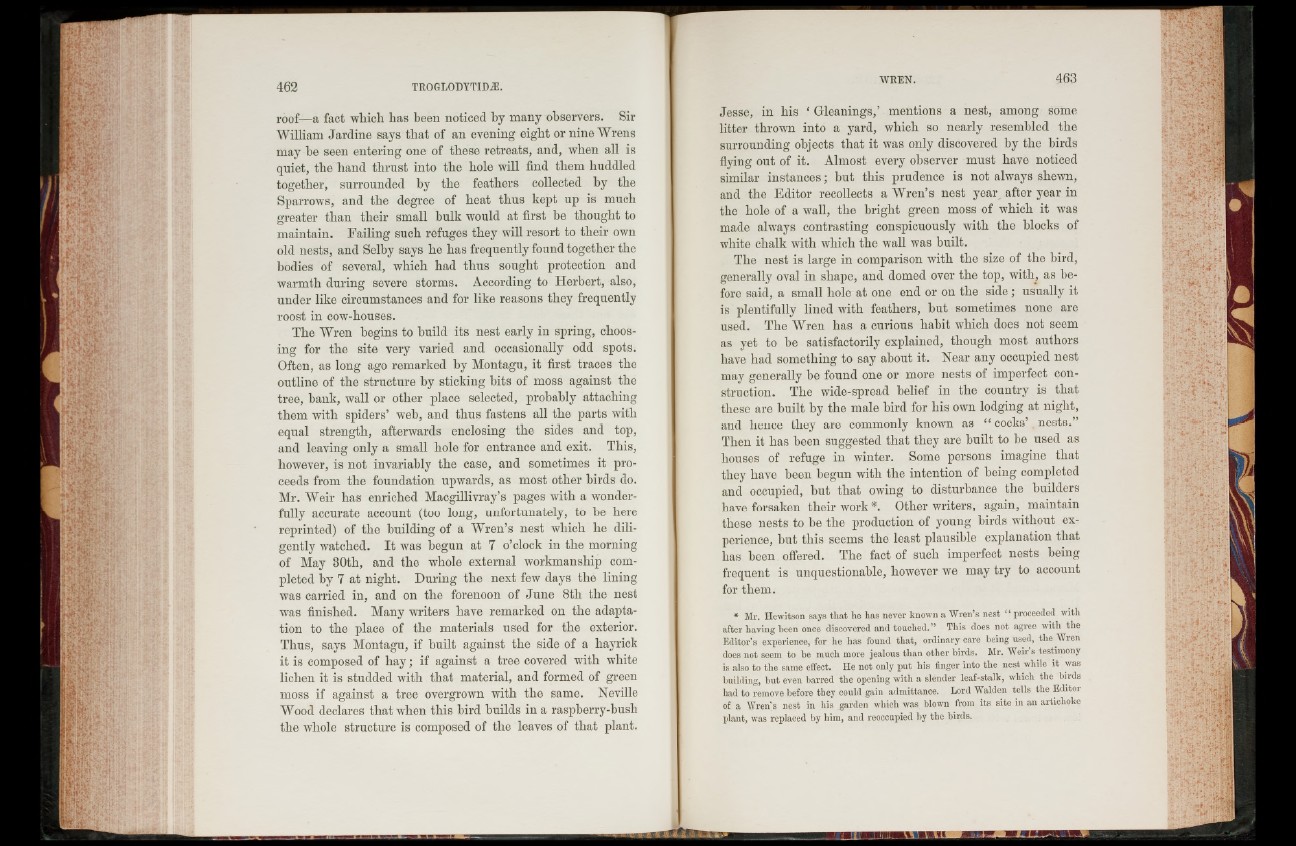
roof—a fact which has been noticed by many observers. Sir
William Jardine says that of an evening eight or nine Wrens
may be seen entering one of these retreats, and, when all is
quiet, the hand thrust into the hole will find them huddled
together, surrounded by the feathers collected by the
Sparrows, and the degree of heat thus kept up is much
greater than their small bulk would at first be thought to
maintain. Failing such refuges they will resort to their own
old nests, and Selby says he has frequently found together the
bodies of several, which had thus sought protection and
warmth during severe storms. According to Herbert, also,
under like circumstances and for like reasons they frequently
roost in cow-houses.
The Wren begins to build its nest early in spring, choosing
for the site very varied and occasionally odd spots.
Often, as long ago remarked by Montagu, it first traces the
outline of the structure by sticking bits of moss against the
tree, bank, wall or other place selected, probably attaching
them with spiders’ tveb, and thus fastens all the parts with
equal strength, afterwards enclosing the sides and top,
and leaving only a small hole for entrance and exit. This,
however, is not invariably the case, and sometimes it proceeds
from the foundation upwards, as most other birds do.
Mr. Weir has enriched Macgillivray’s pages with a wonderfully
accurate account (too long, unfortunately, to be here
reprinted) of the building of a Wren’s nest which he diligently
watched. I t was begun at 7 o’clock in the morning
of May 30th, and the whole external workmanship completed
by 7 at night. During the next few days the lining
was carried in, and on the forenoon of June 8tli the nest
was finished. Many writers have remarked on the adaptation
to the place of the materials used for the exterior.
Thus, says Montagu, if built against the side of a hayrick
it is composed of h ay ; if against a tree covered with white
lichen it is studded with that material, and formed of green
moss if against a tree overgrown with the same. Neville
Wood declares that when this bird builds in a raspberry-bush
the whole structure is composed of the leaves of that plant.
Jesse, in his ‘ Gleanings,’ mentions a nest, among some
litter thrown into a yard, which so nearly resembled the
surrounding objects that it was only discovered by the birds
flying out of it. Almost every observer must have noticed
similar instances; but this prudence is not always shewn,
and the Editor recollects a Wren’s nest year after year in
the hole of a wall, the bright green moss of which it was
made always contrasting conspicuously with the blocks of
white chalk with which the wall was built.
The nest is large in comparison with the size of the bird,
generally oval in shape, and domed over the top, with, as before
said, a small hole at one end or on the side; usually it
is plentifully lined with feathers, but sometimes none are
used. The Wren has a curious habit which does not seem
as yet to be satisfactorily explained, though most authors
have had something to say about it. Near any occupied nest
may generally he found one or more nests of imperfect construction.
The wide-spread belief in the country is that
these are built by the male bird for his own lodging at night,
and hence they are commonly known as “ cocks’ nests.”
Then it has been suggested that they are built to be used as
houses of refuge in winter. Some persons imagine that
they have been begun with the intention of being completed
and occupied, but that owing to disturbance the builders
have forsaken their work *. Other writers, again, maintain
these nests to he the production of young birds without experience,
but this seems the least plausible explanation that
has been offered. The fact of such imperfect nests being
frequent is unquestionable, however we may try to account
for them.
* Mr. Hewitson says tliat he has never known a Wren’s nest “ proceeded with
after having been once discovered and touched.” This does not agree with the
Editor’s experience, for he has found that, ordinary care being used, the Wren
does not seem to be much more jealous than other birds. Mr. Weir s testimony
is also to the same effect. He not only put his finger into the nest while it was
building, but even barred the opening with a slender leaf-stalk, which the birds
had to remove before they could gain admittance. Lord Walden tells the Editor
of a Wren’s nest in his garden which was blown from its site in an artichoke
plant, was replaced by him, and reoccupied by the birds.
1 Hf i »I.c. WYA.Ail